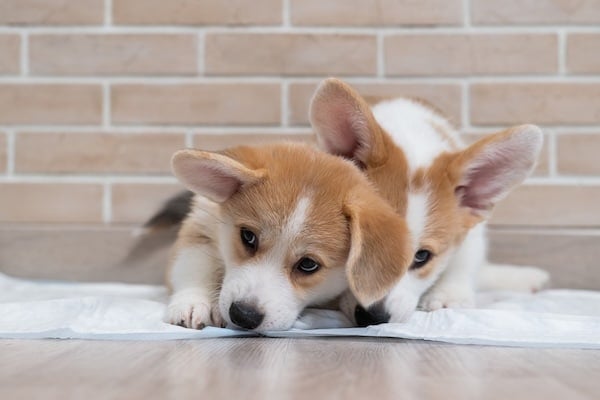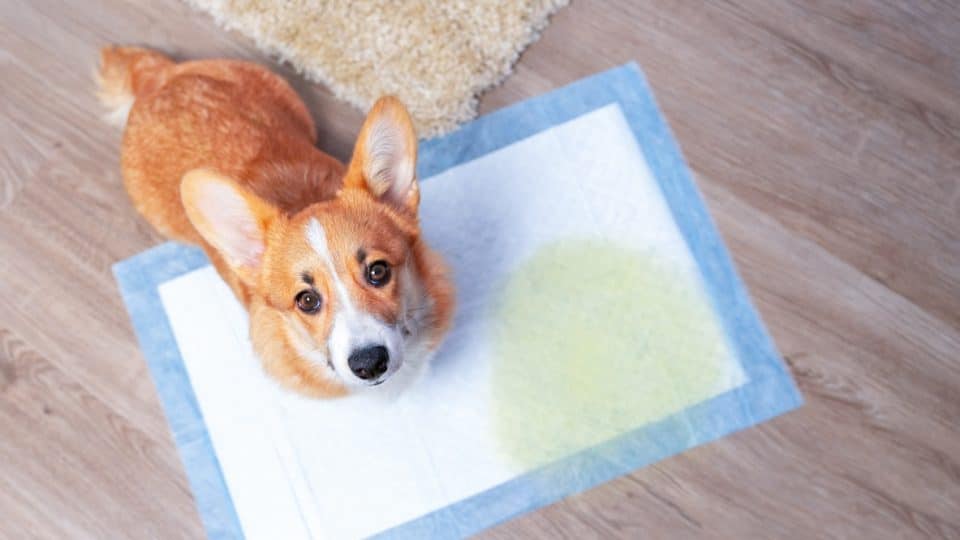- Not a substitute for professional veterinary help.
One of the biggest training hurdles for new puppy parents is potty training. While a backyard is a nice convenience, it’s possible to potty train in an apartment, too. Puppies can learn to use a pee pad, a grass patch, or even a litter box, depending on your space and preferences.
The primary difference between indoor and outdoor potty training is the time it takes to get your dog to the designated potty spot and how easy it is to clean the inevitable accidents. Keep in mind that it can be difficult to catch every potty attempt in an apartment, so give yourself some grace and trust the process.
We spoke with Alexandra Bassett, a lead dog trainer (CPDT-KA) at Dog Savvy, and Dr. Nell Ostermeier, DVM, a veterinary advisor at Figo Pet Insurance, to learn how to potty train a puppy in an apartment.
Setting Up an Apartment Potty Station
The first step in apartment potty training is to establish a specific potty area. This designated space can be indoors or out. For instance, it can be a pee pad in a laundry room, an artificial grass patch on the balcony, or a garden area outside your door.
The most important thing is that you and your puppy can reach it quickly when they start showing signs that they need to potty. You’ll need to stay consistent and take your pup to the same spot each time.
Signs your puppy has to pee
To avoid accidents, familiarize yourself with the signs that your puppy needs an emergency trip to the designated bathroom area. Indicators that your pup needs to go potty include:
- Circling or pacing around the apartment
- Sniffing the floor or a wall
- Whining or vocalizing
- Standing or scratching at a door

Anna Reshetnikova via iStock
Using Indoor Litter Boxes and Pee Pads for Dogs
Potty pads or indoor litter boxes are both good options to use in the designated potty spot. “Pee pads are ideal for puppies with limited outdoor access or if you live in an apartment,” says Bassett. They’re also useful for potty training smaller breeds (with smaller bladders) or puppies in a living setup that makes it hard to get outside fast.
To teach a puppy to use a pee pad or litter box:
- Place the pee pad or box in the designated potty area in your apartment.
- Slowly introduce your puppy to the pee pad or litter box and allow them to sniff around and explore the area.
- Next, start taking your puppy to the pad or litter box for regular potty breaks and any time you see them looking like they need to go.
- Reward them generously with praise or treats every time they potty on the pad or box.
For pee pads and litter boxes to work, you’ll need to keep them in the same spot every time. “Unless a puppy is consistently brought to the pee pad to establish where to potty during the initial stages of training, pee pads may blur boundaries for where a puppy can go, leading to accidents on rugs, carpets, or blankets,” warns Bassett.
You’ll also want to regularly change out pads or litter to keep things fresh. Pups prefer, and are more likely, to potty on a clean surface.
Using Grass Patches on the Balcony
If you have a balcony, setting up a grass patch, with either artificial or real grass, is another great option for potty training in an apartment.
To teach your puppy to use a grass patch:
- Place it in a designated area on the balcony and let your dog sniff and explore it.
- Take your pup to the patch during prime potty opportunities, like immediately after naps and meals, and any time they look like they have to go.
- Reward generously every time your dog uses the patch.
Unlike a pee pad or litter box inside your house, your dog won’t be able to access the grass patch as easily. Keep a watchful eye to determine when you need to take them out to the balcony. You can also put in a doggy door or teach them to ring a bell when they need to go outside.
When cleaning artificial grass, remove waste immediately and rinse the grass regularly. With real grass, you’ll also want to remove waste promptly, but there’s no need to rinse the grass. Instead, you’ll replace it every four to eight weeks with a fresh strip.
Carrying Your Puppy Outside
To potty train outdoors when you live in an apartment, establish a routine. Take the same way to leave the building and go to the same spot of grass or concrete for potty breaks each time.
Since every second matters when it comes to potty breaks, carrying your puppy outside may make sense, especially at the beginning. However, keep in mind that medium and large-breed puppies will become very heavy to carry as they grow, especially if you live on a top floor.
“It’s best to train your puppy to walk outside as part of basic behaviors and socialization. But you may be in a hurry some days, so it’s okay on those occasions to carry your dog,” affirms Dr. Ostermeier.
Keeping a consistent schedule for potty breaks will also help your pup avoid accidents, allowing them to anticipate when their next potty break will happen. A typical schedule for potty training outdoors might include trips outside:
- After waking up in the morning and following any long naps
- After each meal
- After playtime sessions
- Before bedtime
-
Yana Tikhonova via iStock
Tips for Potty Training a Dog in an Apartment
Bassett says that potty training a puppy in an apartment can take around one to three months. “Puppies typically need time to develop bladder control, but with consistent reinforcement and a structured schedule, you can speed up the process and establish reliable indoor potty habits,” she explains.
Dr. Ostermeier agrees, emphasizing the need for a consistent routine and feeding schedule, frequent potty breaks, and a good place to chill when they can’t be watched. Here’s what to know.
Keep the potty spot consistent
Whether indoors on a pee pad or outside your apartment building, establishing a reliable routine will help speed up the potty training timeline. You’ll also want to ensure that your pup’s designated potty area is in a quiet area where they won’t be disturbed. Laundry rooms, bathrooms, or quiet corners all make good low-traffic spots.
Reward your puppy when they go in the correct spot
Positive feedback is crucial in helping your dog learn to potty in the right location, especially when living in an apartment. Along with verbal praise, reward your puppy with a high-value treat for each successful potty. “Throwing a party” each time they go to the bathroom in the designated area will reinforce their desire to do it again. You can also use clicker training or teach your puppy to potty on cue.
Clean up accidents right away
Since the scent of urine can encourage a puppy to use the same potty spot again, it’s important to immediately clean up any indoor accidents that happen outside the designated potty area. An enzymatic cleaner is excellent for pet accidents as it effectively breaks down the scent, rather than just masking it. In a pinch, you can also use a 1:1 ratio of white vinegar and water to help neutralize any lingering odors.
Keep your puppy confined or close by
It’s a good idea to keep a close eye on your puppy and limit full access to your apartment while you potty train them. Have your pup drag a leash, so you can easily pick them up and take them to the potty spot. Block off an easy-to-clean area, such as the kitchen or living room, with playpens or gates.
Using a crate to potty train your puppy in an apartment can also be extremely helpful. Dogs like to keep their resting area clean, so they’re less likely to have accidents inside a crate.
Pro tip: Use a crate with a divider when potty training in an apartment. This type of crate will give your pup plenty of room to grow while blocking off extra space that might tempt them to potty inside it.
Modify your schedule as your puppy grows
Just like you would for outdoor potty breaks, you’ll also build a routine around how long your puppy can hold their pee. As your puppy gets used to potty training and develops bladder control, you can extend the time between potty breaks as necessary.
Pros and Cons of Potty Training Your Puppy Indoors
There are quite a few advantages to training your pup to use the bathroom indoors. For instance, it establishes an easily accessible route for potty time, especially if it’s hard to get outside quickly.
It also allows you to start potty training in your apartment before your puppy’s full round of vaccinations. By keeping them close to areas you know are safe and haven’t been frequented by other pups or wildlife, you won’t have to worry about them picking up infectious diseases.
The downside, according to Bassett, is that once you’ve taught your dog to potty inside, transitioning from indoor to outdoor training can be more challenging later on. While not impossible, training your pup to use the potty outside after toilet training them indoors may confuse them.
Is one better than the other?
“Ultimately, outdoor training is often preferred because it eliminates indoor mess and reduces the chance of accidents in unwanted areas,” says Bassett. “However, indoor potty training is a good alternative when outdoor access is limited or not feasible.”
If toilet training indoors is your ultimate goal, there’s no need to train them outdoors. Overall, both methods are suitable choices that depend on your and your pup’s needs and unique living situation.




